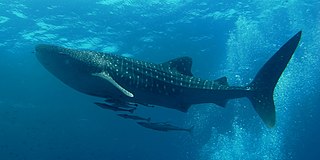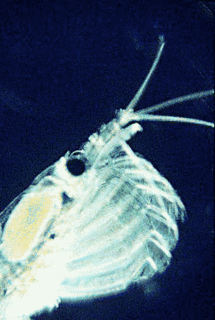
A gill is a respiratory organ found in many aquatic organisms that extracts dissolved oxygen from water and excretes carbon dioxide. The gills of some species, such as hermit crabs, have adapted to allow respiration on land provided they are kept moist. The microscopic structure of a gill presents a large surface area to the external environment. Branchia is the zoologists' name for gills.

The whale shark is a slow-moving, filter-feeding carpet shark and the largest known extant fish species. The largest confirmed individual had a length of 18.8 m (62 ft). The whale shark holds many records for size in the animal kingdom, most notably being by far the largest living nonmammalian vertebrate. It is the sole member of the genus Rhincodon and the only extant member of the family Rhincodontidae, which belongs to the subclass Elasmobranchii in the class Chondrichthyes. Before 1984 it was classified as Rhiniodon into Rhinodontidae.

Filter feeders are a sub-group of suspension feeding animals that feed by straining suspended matter and food particles from water, typically by passing the water over a specialized filtering structure. Some animals that use this method of feeding are clams, krill, sponges, baleen whales, and many fish. Some birds, such as flamingos and certain species of duck, are also filter feeders. Filter feeders can play an important role in clarifying water, and are therefore considered ecosystem engineers. They are also important in bioaccumulation and, as a result, as indicator organisms.

The basking shark is the second-largest living shark, after the whale shark, and one of three plankton-eating shark species, along with the whale shark and megamouth shark. Adults typically reach 7.9 m (26 ft) in length. It is usually greyish-brown, with mottled skin. The caudal fin has a strong lateral keel and a crescent shape.
In marine and freshwater ecology, a particle is a small object. Particles can remain in suspension in the ocean or freshwater. However, they eventually settle and accumulate as sediment. Some can enter the atmosphere through wave action where they can act as cloud condensation nuclei (CCN). Many organisms filter particles out of the water with unique filtration mechanisms. Particles are often associated with high loads of toxins which attach to the surface. As these toxins are passed up the food chain they accumulate in fatty tissue and become increasingly concentrated in predators. Very little is known about the dynamics of particles, especially when they are re-suspended by dredging. They can remain floating in the water and drift over long distances. The decomposition of some particles by bacteria consumes much oxygen and can cause the water to become hypoxic.

Leedsichthys is a giant member of the Pachycormidae, an extinct group of Mesozoic ray-finned fish that lived in the oceans of the Middle Jurassic period. It is the largest ray-finned fish known to have existed.

The Atlantic menhaden is a North American species of fish in the herring family, Clupeidae.

Pelagic fish live in the pelagic zone of ocean or lake waters – being neither close to the bottom nor near the shore – in contrast with demersal fish that do live on or near the bottom, and reef fish that are associated with coral reefs.

Sea apple is a common name for the colorful and somewhat round sea cucumbers of the genera Pseudocolochirus, found in Indo-Pacific waters. Sea apples are filter feeders with tentacles, ovate bodies, and tube-like feet. As with many other holothurians, they can release their internal organs or a toxin into the water when stressed.

In biology, detritus is dead particulate organic material, as distinguished from dissolved organic material. Detritus typically includes the bodies or fragments of bodies of dead organisms, and fecal material. Detritus typically hosts communities of microorganisms that colonize and decompose it. In terrestrial ecosystems it is present as leaf litter and other organic matter that is intermixed with soil, which is denominated "soil organic matter". The detritus of aquatic ecosystems is organic material that is suspended in the water and accumulates in depositions on the floor of the body of water; when this floor is a seabed, such a deposition is denominated "marine snow".

The silver carp is a species of freshwater cyprinid fish, a variety of Asian carp native to China and eastern Siberia. Although a threatened species in its natural habitat, it has long been cultivated in China. By weight more silver carp are produced worldwide in aquaculture than any other species of fish except for the grass carp. Silver carp are usually farmed in polyculture with other Asian carp, or sometimes with catla or other fish species.

The Unionidae are a family of freshwater mussels, the largest in the order Unionida, the bivalve molluscs sometimes known as river mussels, or simply as unionids.

In animal anatomy, the mouth, also known as the oral cavity, buccal cavity, or in Latin cavum oris, is the opening through which many animals take in food and issue vocal sounds. It is also the cavity lying at the upper end of the alimentary canal, bounded on the outside by the lips and inside by the pharynx and containing in higher vertebrates the tongue and teeth. This cavity is also known as the buccal cavity, from the Latin bucca ("cheek").

A bottom feeder is an aquatic animal that feeds on or near the bottom of a body of water. Biologists often use the terms benthos—particularly for invertebrates such as shellfish, crabs, crayfish, sea anemones, starfish, snails, bristleworms and sea cucumbers—and benthivore or benthivorous, for fish and invertebrates that feed on material from the bottom. However the term benthos includes all aquatic life that lives on or near the bottom, which means it also includes non-animals, such as plants and algae. Biologists also use specific terms that refer to bottom feeding fish, such as demersal fish, groundfish, benthic fish and benthopelagic fish. Examples of bottom feeding fish species groups are flatfish, eels, cod, haddock, bass, grouper, carp, bream (snapper) and some species of catfish and shark.
Pseudofeces or pseudofaeces are a specialized method of expulsion that filter-feeding bivalve mollusks use in order to get rid of suspended particles such as particles of grit which cannot be used as food, and which have been rejected by the animal. The rejected particles are wrapped in mucus, and are then expelled without having passed through the digestive tract. Thus, although they may closely resemble the mollusk's real feces, they are not actually feces, hence the name pseudofeces, meaning false feces.

Forage fish, also called prey fish or bait fish, are small pelagic fish which are preyed on by larger predators for food. Predators include other larger fish, seabirds and marine mammals. Typical ocean forage fish feed near the base of the food chain on plankton, often by filter feeding. They include particularly fishes of the family Clupeidae, but also other small fish, including halfbeaks, silversides, smelt such as capelin and goldband fusiliers.

Due to the higher density of sea water than air, the force exerted by the same velocity on an organism is 827 times stronger in the ocean. When waves crash on the shore, the force exerted on littoral organisms can be equivalent to several tons.

Aquatic feeding mechanisms face a special difficulty as compared to feeding on land, because the density of water is about the same as that of the prey, so the prey tends to be pushed away when the mouth is closed. This problem was first identified by Robert McNeill Alexander. As a result, underwater predators, especially bony fish, have evolved a number of specialized feeding mechanisms, such as filter feeding, ram feeding, suction feeding, protrusion, and pivot feeding.

Fish gills are organs that allow fish to breathe underwater. Most fish exchange gases like oxygen and carbon dioxide using gills that are protected under gill covers (operculum) on both sides of the pharynx (throat). Gills are tissues that are like short threads, protein structures called filaments. These filaments have many functions including the transfer of ions and water, as well as the exchange of oxygen, carbon dioxide, acids and ammonia. Each filament contains a capillary network that provides a large surface area for exchanging oxygen and carbon dioxide.



















